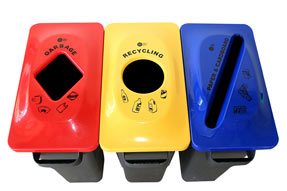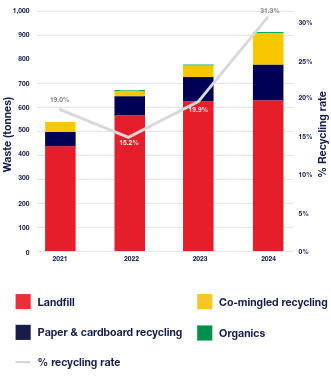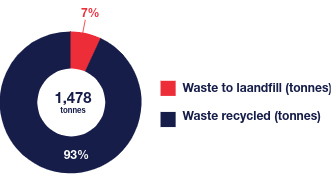Circular economy and recycling

The circular economy aims to transform the current mindset of the take-make-waste linear model towards circularity, where waste and pollution is eliminated through good design, and the life of existing materials are prolonged through new and innovative ways of repairing, reusing and remanufacturing.
We have a Circular Economy Plan which aims to provide direction on how RMIT can integrate the principles of the circular economy into practices in the operation and development of our campuses.
The key objectives of the plan are to:
The Sustainability Team and the wider Property Service Group have been focusing on embedding the principles of the circular economy into the building portfolio operations and processes. The project aims to ensure that the environmental and economic benefits of embedding circularity are articulated, new methodologies and a measurement tool established and that the positive impacts are calculated.
The Circular Economy Project aims to:
The Circular Economy Hub (CEH) at RMIT is a cross-disciplinary, industry-engaged network of around 60 researchers and experts across the University working on cutting edge and innovative Circular Economy (CE) research across Australia and internationally.
The work supports RMIT as an industry leader in circular economy research at national and global forums. The CEH’s cross-disciplinary nature supports empirical approaches to holistic and systemic engagement across research partnerships, expanding the university’s impact and expertise on CE. It also supports the emergence of a new capability-building platform across micro-credentials, executive training, vocational and higher educational outcomes.
RMIT is leading the ARC Industrial Transformation Research Hub for Transformation of Reclaimed Waste Resources to Engineered Materials and Solutions for a Circular Economy (TREMS) which focuses on reducing landfill waste and transforming reclaimed waste into new materials for use in construction and other manufacturing sectors. The hub draws from expertise across multiple disciplines including civil, chemical, materials and construction engineering, artificial intelligence, behavioural sciences, environmental procurements and policies and standards.
For more information, visit:
RMIT Activator is the University’s growth engine for entrepreneurship and innovation. RMIT Activator has developed its programs and partnerships to align with RMIT’s strategic ambitions for sustainability and the UN Sustainable Development Goals (SDGs). RMIT Activator strives to expose students to ‘wicked problems worth solving’, through experiential programming, supports capability development and the connections needed to make a practical difference.
Activator supports a range of initiatives to drive the circular economy, including incubator and pre-accelerator programs, hackathons, pitch events, mentoring programs and industry collaborations. Presented by RMIT Activator and supported by LaunchVic the [Re]Launch Incubator is Victoria’s leading program for innovators building impactful ideas centred on circular solutions.
We promote the waste hierarchy of ‘Reduce, Reuse, Recycle’ to minimise our impact on the environment. Too often we focus on only recycling our waste, without firstly considering if we can eliminate the waste or limit the amount of waste produced by reusing items.
Here are some things as part of the RMIT community you can do to help reduce waste:
RMIT has a standard three bin system across all campuses within staff office areas, and some general areas in convenient, centralised locations. The University also provides organics bins to all back-of-house retail areas and will be progressively rolling out organics bins to staff kitchens.
Contamination in our bins prevents items from being recycled. We keep the streams simple to reduce confusion and if in doubt, throw it out.
 RMIT's standard three bin system
RMIT's standard three bin system
Mixed recycling |
Paper/cardboard |
Landfill |
Organics |
|
|
|
(Note compostable or biopak packaging is not allowed) |
RMIT supports the recycling of all materials that can be recycled, and only a small amount of residue waste should end up in landfill. However, due to the operational constraints at RMIT as well as some limitations to the current Victorian waste industry's recycling capabilities, RMIT cannot provide collection services for low-volume and unique recyclable waste streams. Instead, RMIT focuses on waste avoidance and improving our landfill diversion rates for our high-volume, primary waste streams.
Individuals, portfolios and colleges can implement initiatives to reduce their waste footprint. The RMIT Sustainability Team are happy to provide advice on how waste can be further reduced or segregated to minimise landfill contributions.
If you have questions or ideas please email sustainability@rmit.edu.au.
E-waste is any electrical or electronic equipment that has been discarded. Anything that is powered by an electrical source is classified as e-waste.
Examples of e-waste include:
The amount of e-waste (electronic waste) we create is growing up to three times faster than general municipal waste in Australia. These items contain both hazardous and valuable materials that can be recovered when they reach the end of their working life.
Most of RMIT IT assets are leased and must be returned back to the supplier at the end of its life and should not be disposed of, any issues should be reported to IT Service Connect.
If any other electronic equipment is not a leased asset, it must be put in a dedicated e-waste bin. To ensure that the electronic equipment is disposed of correctly, students and staff can return e-waste to the on-campus Walkup TechBAR support locations or can contact propserv.service.desk@rmit.edu.au and specifically request 'e- waste disposal'.
Batteries can be dropped off at the on-campus Walkup TechBAR support locations. Alternatively, you can order a Battery Bucket for your area through:
Property Services, Service Desk
Phone: 03 9925 2111
Email: propserv.service.desk@rmit.edu.au.
A cost centre is required for the delivery of the bucket and $148 (ex GST) will be charged back on collection, this cost includes the supply of the bucket, the costs of recycling and certification on empty.
RMIT printers are supplied and managed by Ricoh, this service includes the replacement of toner cartridges in RMIT printers by their technicians. Any issues should be reported to IT Service Connect.
To minimise typical office supplies going into landfill during an office clean out, order a box or cage from Green Collect.
Green Collect specialises in finding the best environmental solution for a variety of hard to recycle office items such as small electrical items, folders, ring binders, pens, pencils, sticky notes, document trays, DVDs, shredders, etc.
RMIT is committed to avoiding the disposal of any furniture if it is still fit-for-purpose and safe for occupants to use. Furniture cannot be recycled in RMIT's primary waste streams as it is made from many composite materials that cannot be separated easily. To ensure that furniture is reused, repaired, repurposed before it is disposed of, RMIT staff should contact propserv.service.desk@rmit.edu.au
Multi-sort waste bins (red, yellow and blue) can be ordered through propserv.service.desk@rmit.edu.au, but will be placed based on floorplan layouts to ensure bin locations are optimised. If you are running an event, or have a significant amount of waste, extra ad-hoc bins can also be ordered through the Service Desk.
Generally, cleaners will do this if they notice contamination of the recyclable stream (for example, a half-eaten sandwich). To avoid this please ensure your recyclable materials are free from contamination prior to placing in a recyclable bin. We strive for continual improvement with our contractors to ensure they dispose of waste and recyclings correctly.
Soft plastics are one of the most difficult materials to recycle because they are frequently contaminated and often made from different types of plastics that are not easily processed. Reliable, long-term soft plastics recycling programs are not able to succeed without sufficient recycling infrastructure and viable end markets for the recycled material. The major supermarkets Coles, Woolworth and Aldi have formed a Soft Plastics Taskforce, as they have a large influence over the use of recycled materials and promoting stronger end-markets. RMIT continues to monitor this space for viable solutions
The Container Deposit Scheme (CDS) is a recycling program that has a primary goal to reduce landfill waste and promote recycling by creating financial incentives for individuals to return used beverage containers for recycling. RMIT’s mixed recycling streams are heavily contaminated in public areas, making any CDS scheme difficult to implement due to their stringent controls around contamination. The CDS scheme is also operated by different companies across our campus areas, which are different from our waste contractors that service our campuses. RMIT is continuing to track the implementation of the scheme and is trying to identify suitable solutions, which may include small scale reverse vending machines. To find your nearest collection point or find a local charity or community groups that may be using the scheme to fund raise, visit the CDS website.
The RMIT Australian waste profile comprises operational waste collected from points throughout our campuses, with our waste management contractors providing data on waste to landfill, mixed recycling, paper/cardboard, and organic waste, as well as contamination rates. Operational waste excludes confidential paper waste, e-waste, and materials collected from workshops, which are managed separately. While recycling rates have improved to around 31 per cent, it is important to note that overall operational waste tonnages have not yet returned to pre-COVID levels.
Compared to 2018 and 2019, when annual waste volumes exceeded 1,200 tonnes, total waste generated in 2024 remains lower, at 933 tonnes. This trend reflects a broader shift in campus activity patterns post-pandemic, as well as ongoing efforts to reduce waste at the source. Contamination remains an issue for RMIT, high traffic areas and the permeability of our campuses to the broader city make material flows and behaviour change challenging to influence and control. RMIT continues to advance the actions outlined in our Circular Economy Plan. Throughout 2024, collaborated closely with our facilities management staff and contractors, to develop and implement targeted initiatives that support increased recycling rates, reduce contamination and improve diversion outcomes across our campuses.
 RMIT Australia's Operational Waste Profile consists of landfill, organics, paper and cardboard recycling, and co-mingled recycling. Recycling rates have continued on an upward trajectory, 19% in 2021, 15.2% in 2022, 19.9% in 2023, and 31.3% in 2024. Whilst the recycling rate has improved, it is important to note that operational waste tonnages have not yet returned to pre-pandemic levels.
RMIT Australia's Operational Waste Profile consists of landfill, organics, paper and cardboard recycling, and co-mingled recycling. Recycling rates have continued on an upward trajectory, 19% in 2021, 15.2% in 2022, 19.9% in 2023, and 31.3% in 2024. Whilst the recycling rate has improved, it is important to note that operational waste tonnages have not yet returned to pre-pandemic levels.
RMIT collates Construction and Demolition (C&D) waste data from all capital development projects, with a benchmark to recycle a minimum of 90 per cent of all construction and demolition waste. C&D waste data is provided by the principal contractor on each of RMIT's capital projects. In 2024, the University had thirteen active capital development projects providing C&D waste data. From these projects, 1,448 tonnes of waste was produced and 93 per cent was diverted. This is a considerable increase in tonnage from the previous year (563 tonnes), due to the construction of a new building which is our VE Trades Hub facility in Bundoora. RMIT reduces waste from capital development projects by putting circular economy principles into practice, such as prioritising reuse, upcycling, and repurposing furniture before buying new items.
The updated furniture management solution provides a comprehensive system to assess, store, repurpose, reupholster, and reuse furniture across our campuses wherever viable. These efforts are designed to maximise the lifespan of existing resources and reduce the need for new purchases.
 RMIT Australia Construction and Demolition Waste: In 2024, the University had 13 active capital development projects providing C&D waste data. From these projects, 1,448 tonnes of waste was produced and 93 per cent was diverted from landfill.
RMIT Australia Construction and Demolition Waste: In 2024, the University had 13 active capital development projects providing C&D waste data. From these projects, 1,448 tonnes of waste was produced and 93 per cent was diverted from landfill.


RMIT University acknowledges the people of the Woi wurrung and Boon wurrung language groups of the eastern Kulin Nation on whose unceded lands we conduct the business of the University. RMIT University respectfully acknowledges their Ancestors and Elders, past and present. RMIT also acknowledges the Traditional Custodians and their Ancestors of the lands and waters across Australia where we conduct our business - Artwork 'Sentient' by Hollie Johnson, Gunaikurnai and Monero Ngarigo.
Learn more about our commitment to Indigenous cultures